
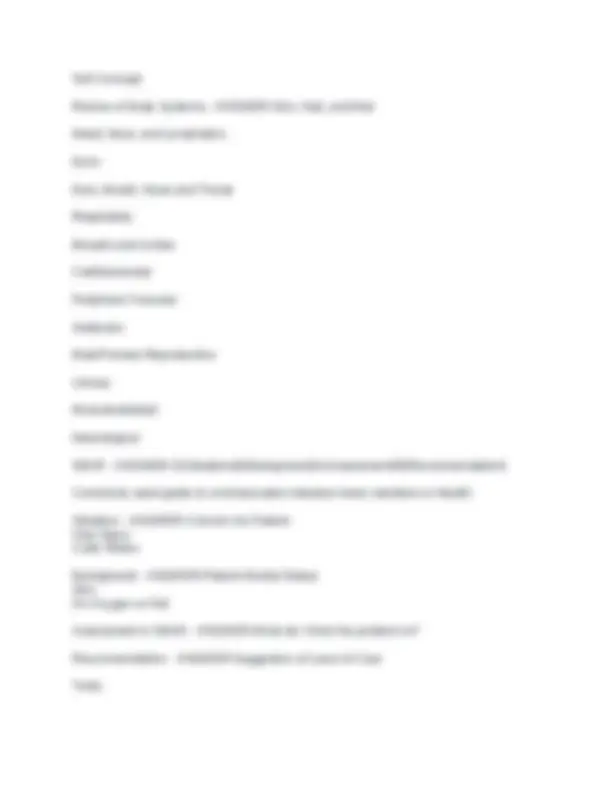
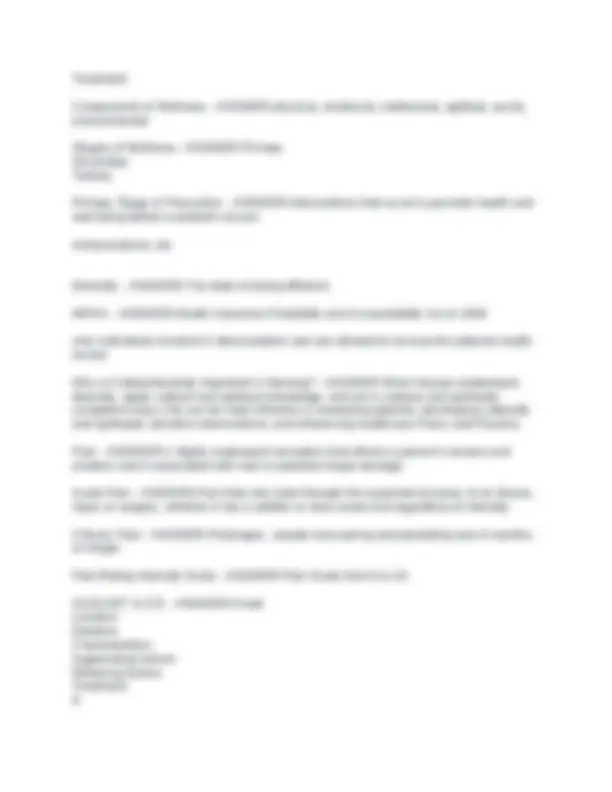
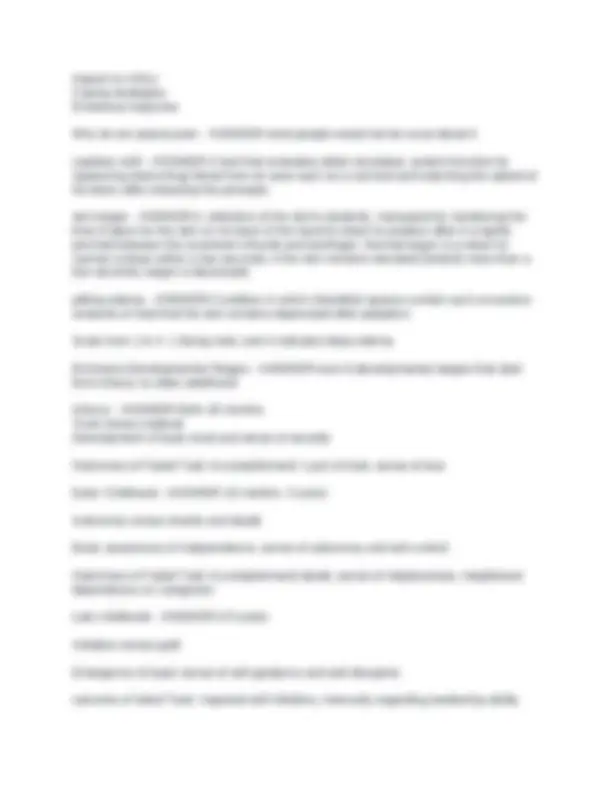
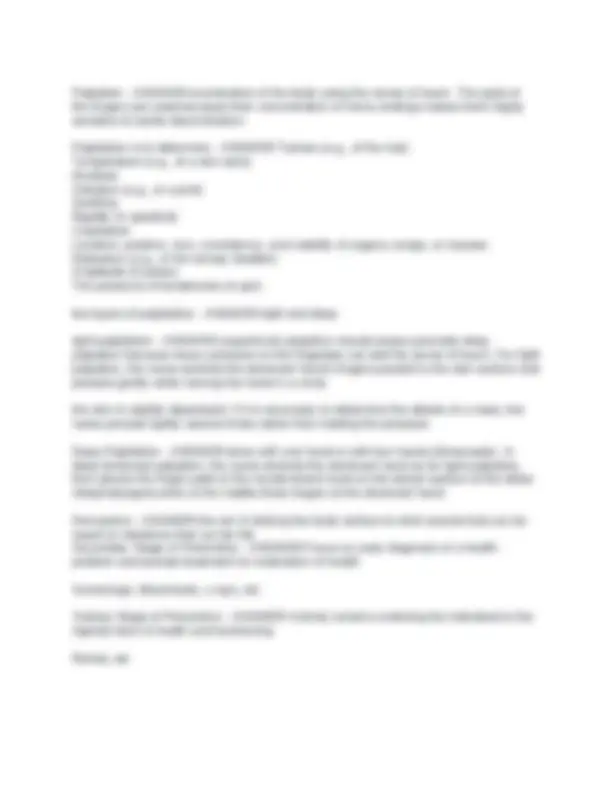
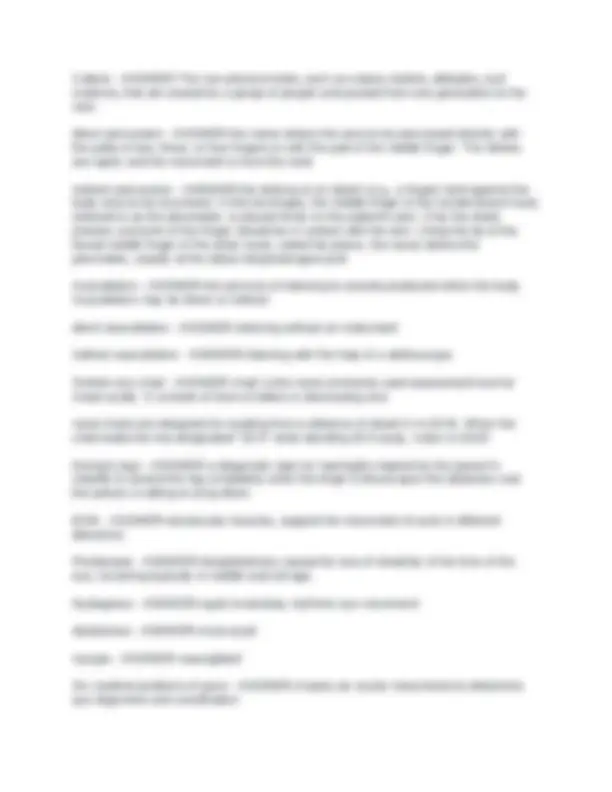
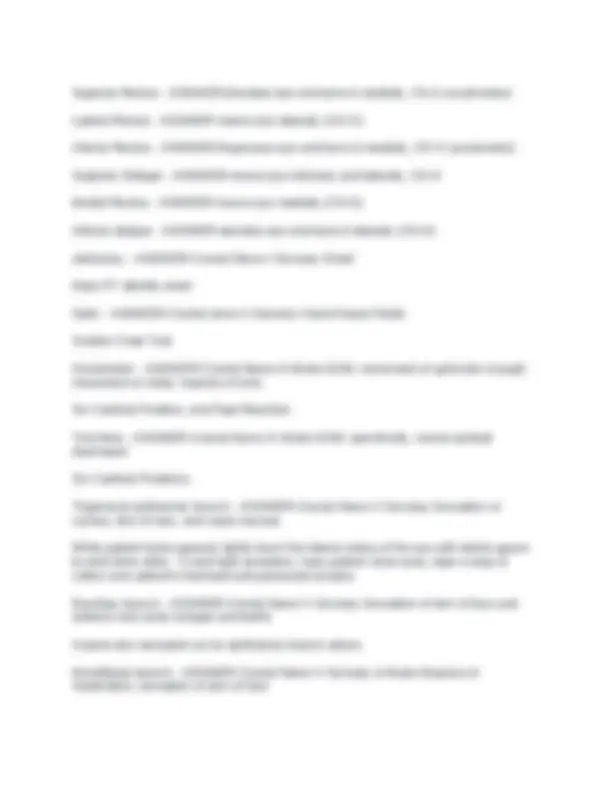
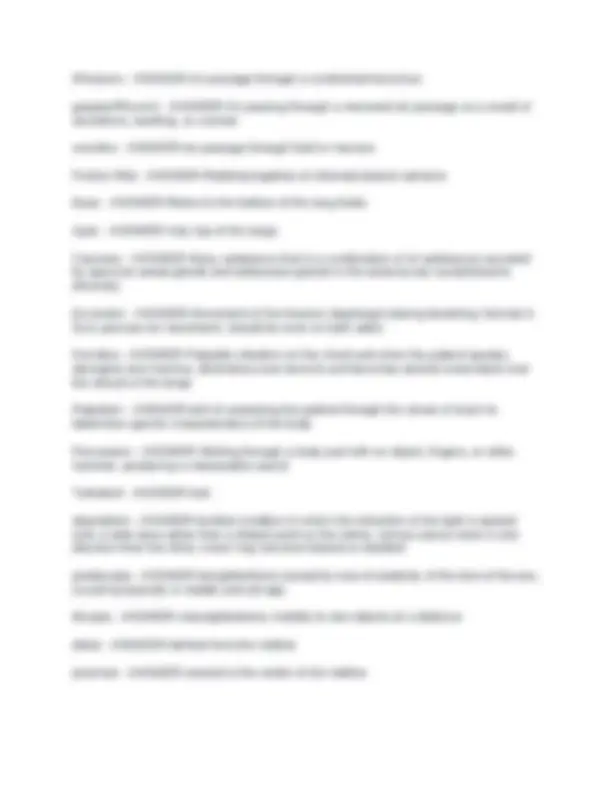
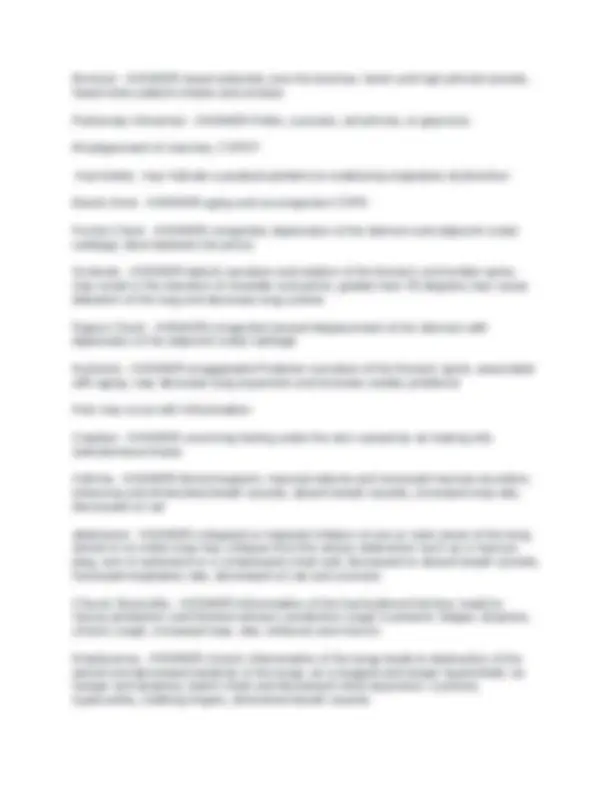
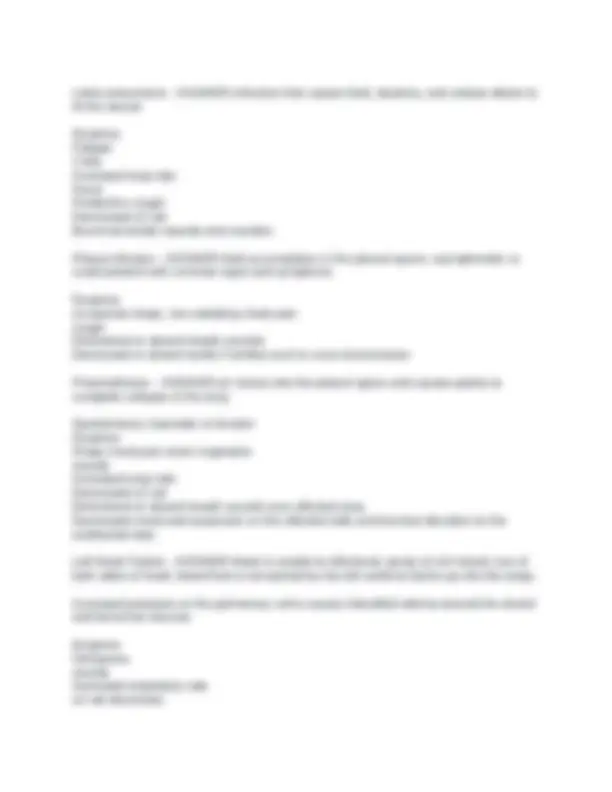
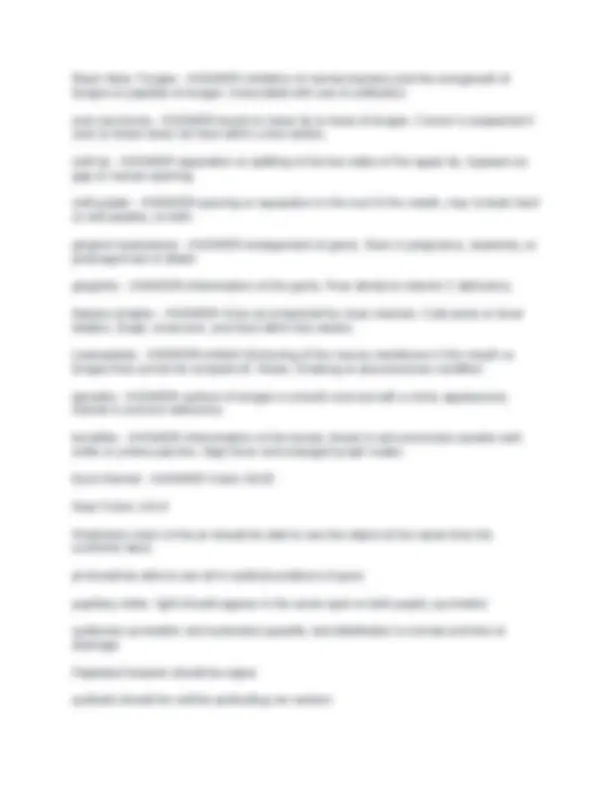
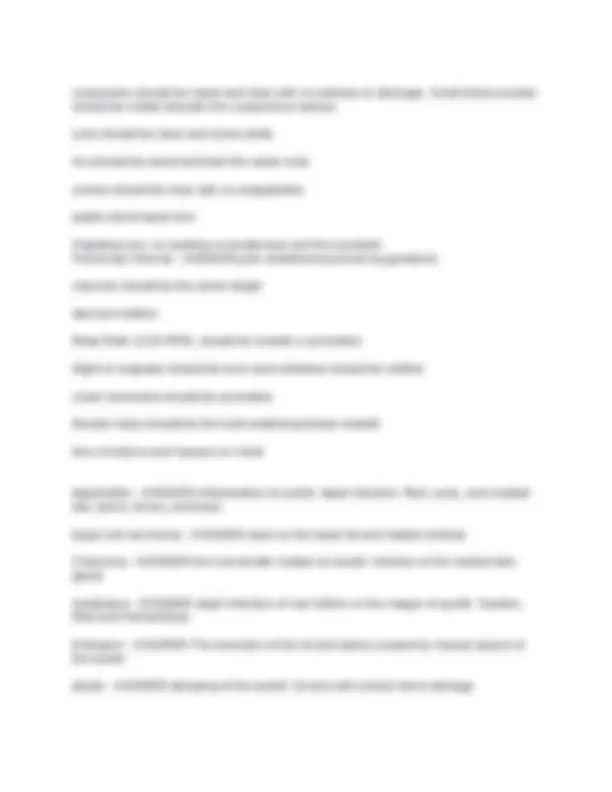
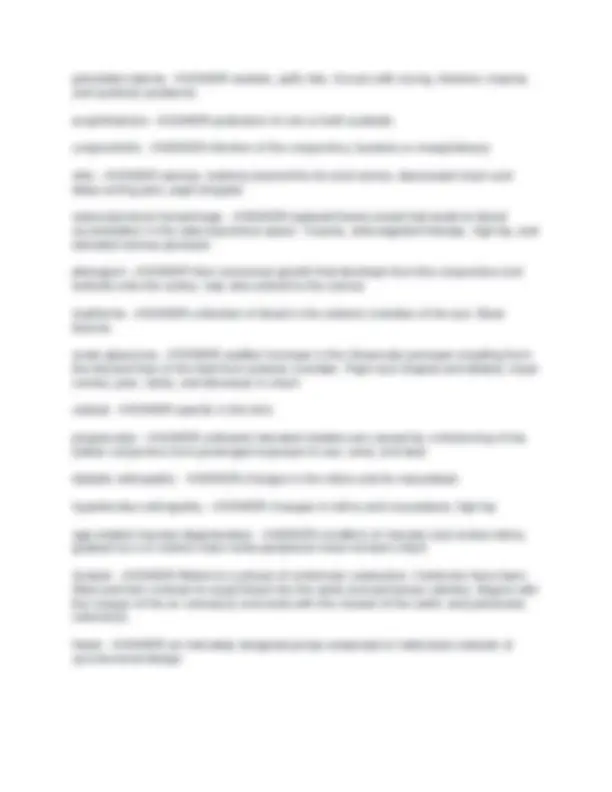
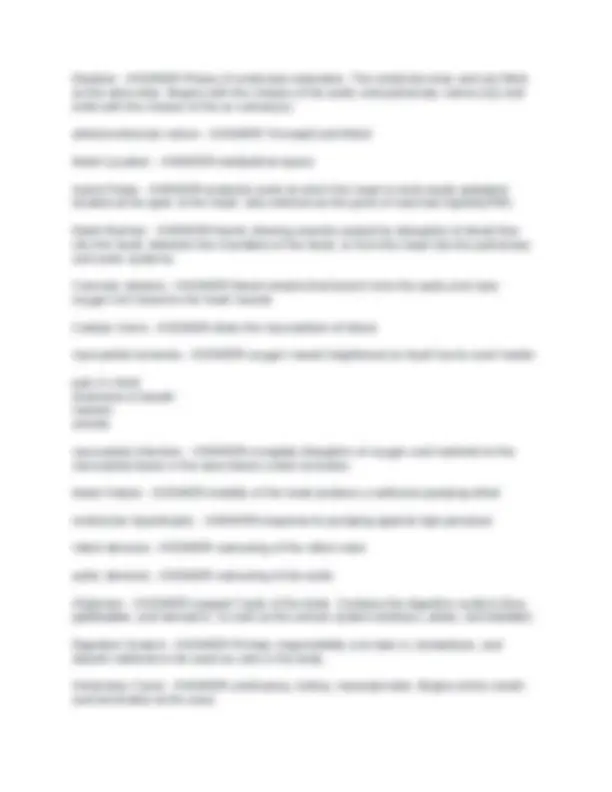
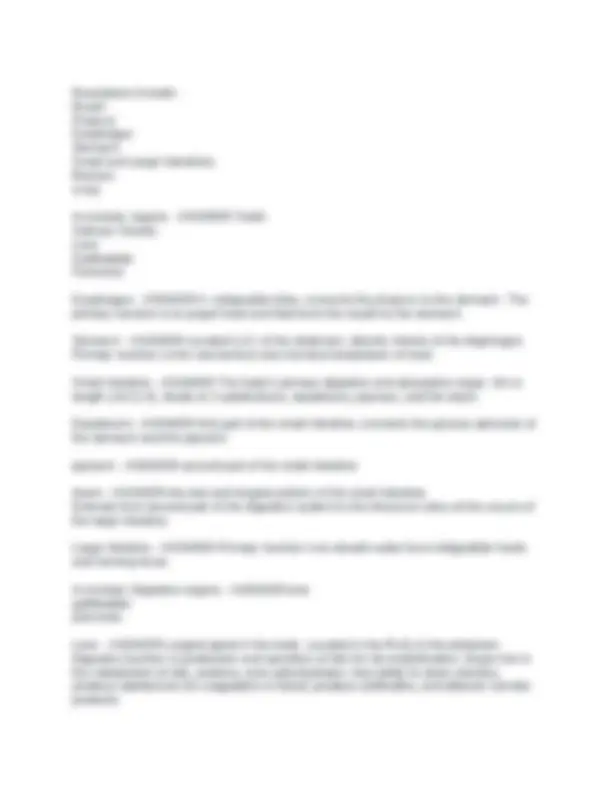
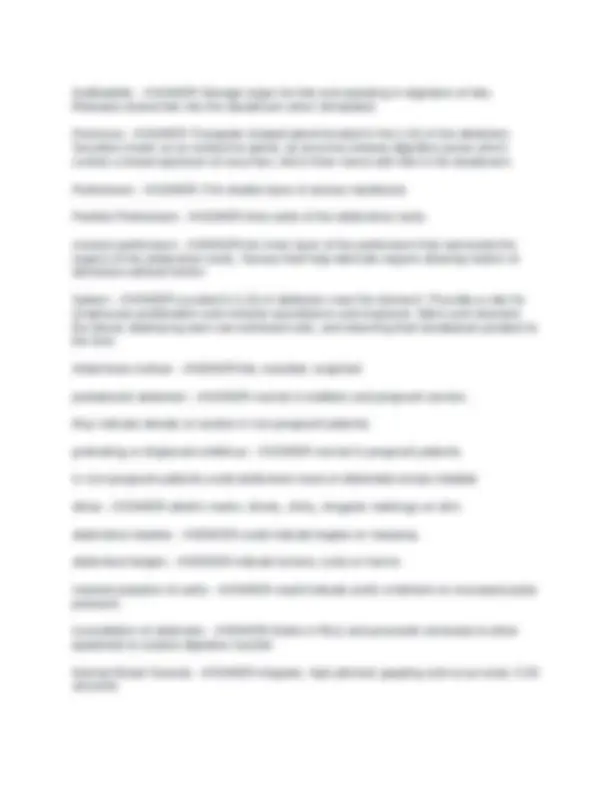
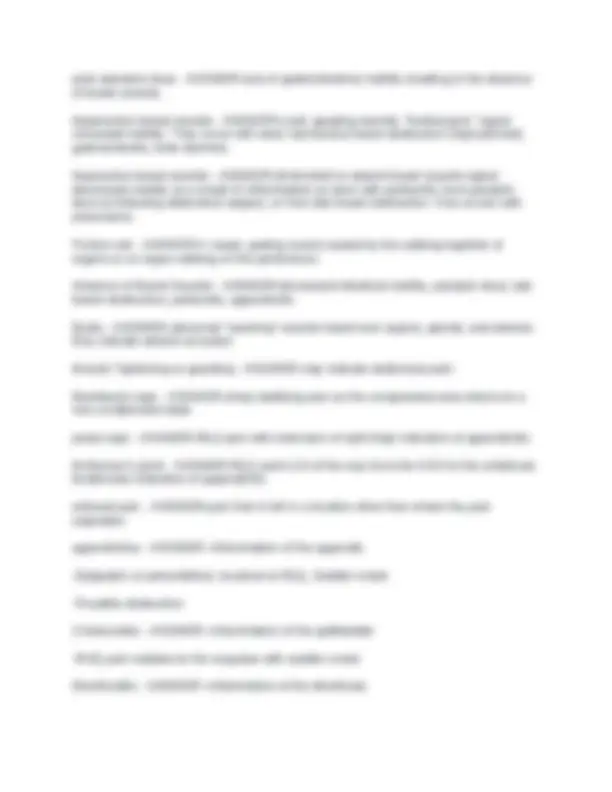
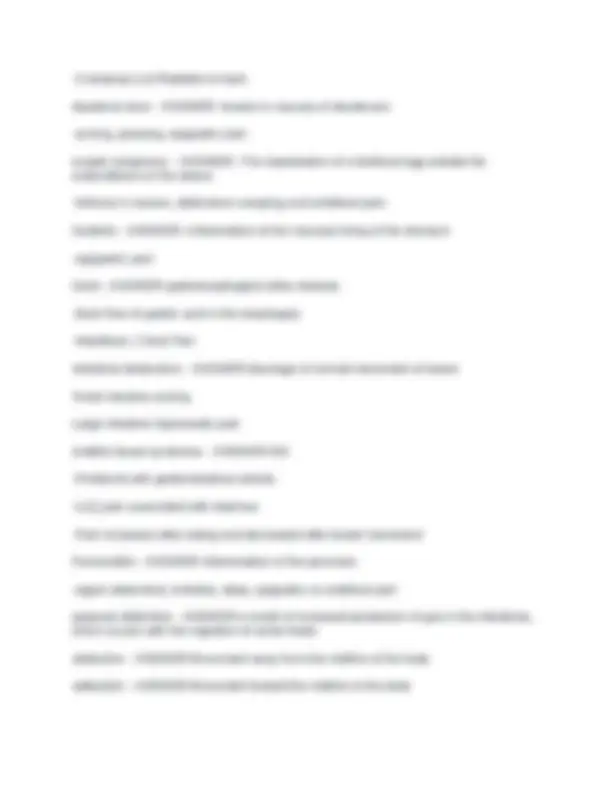
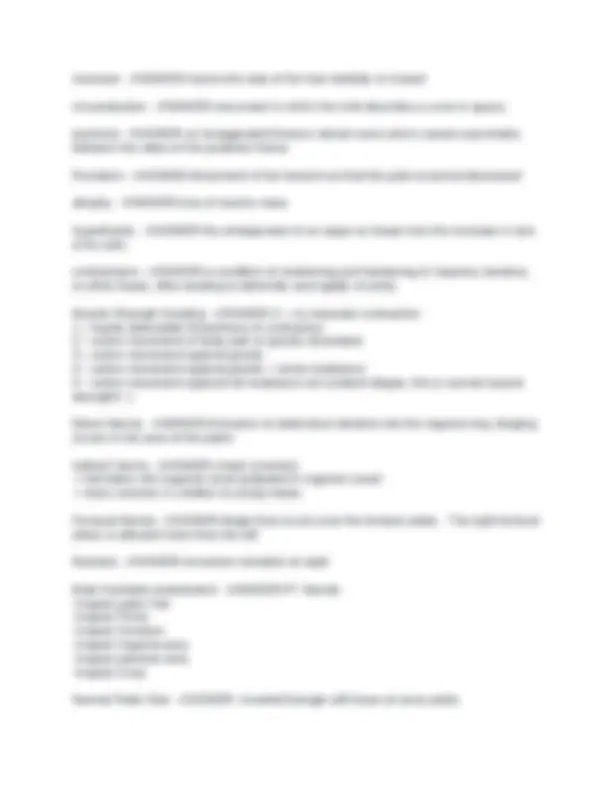
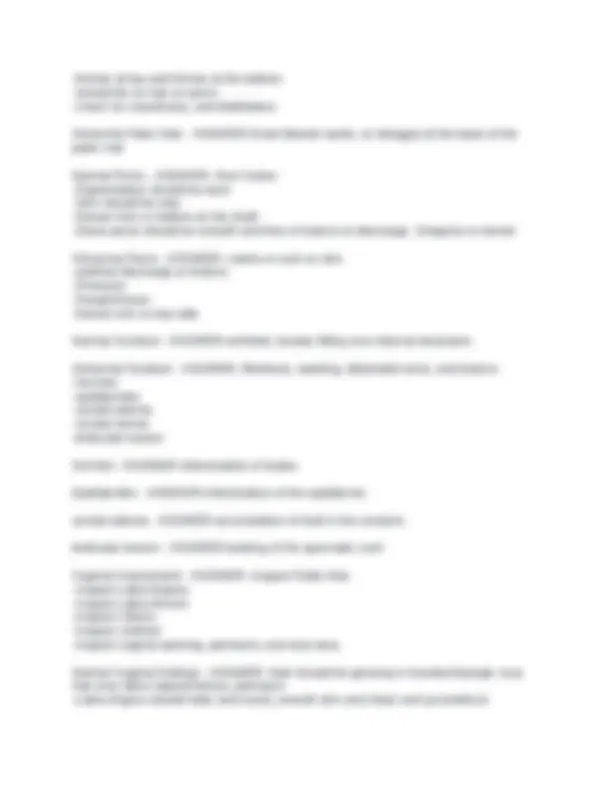
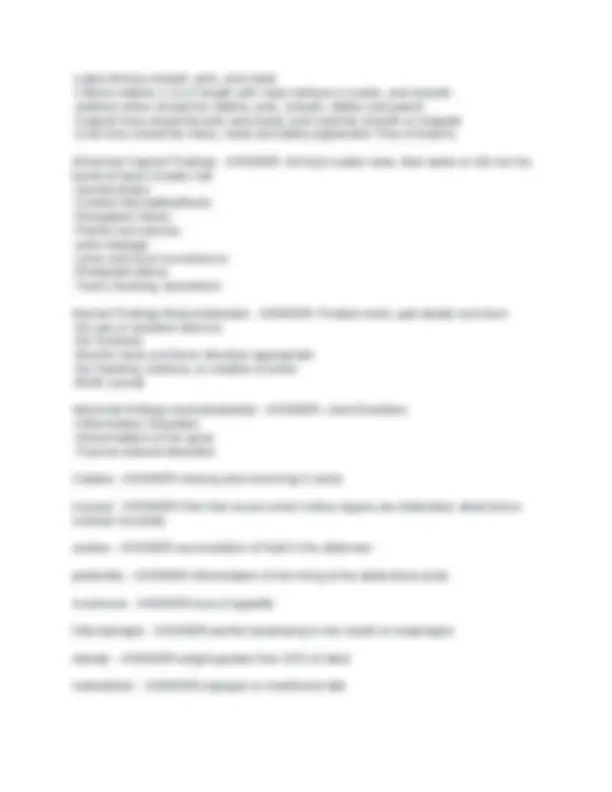
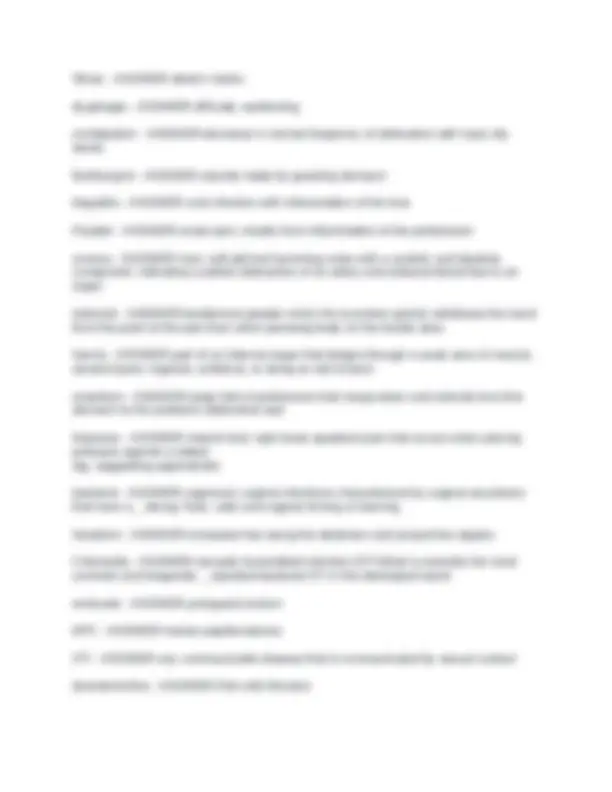
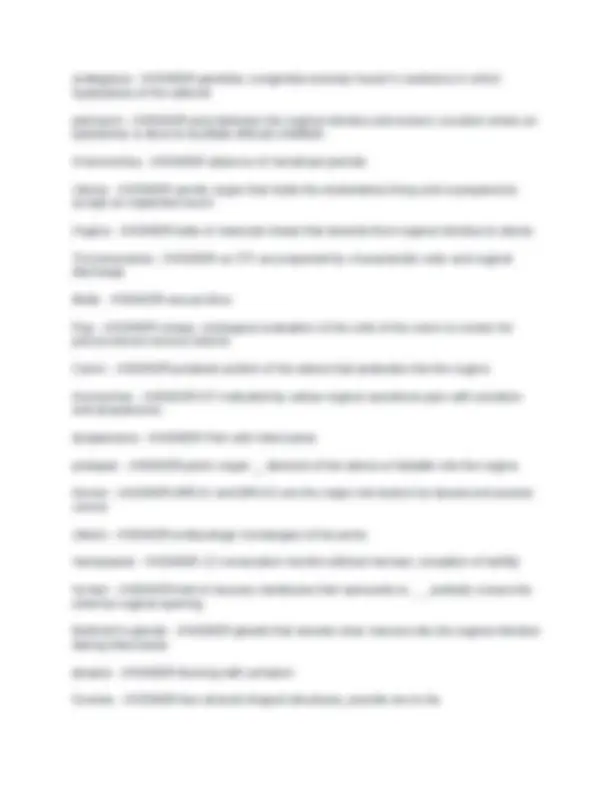
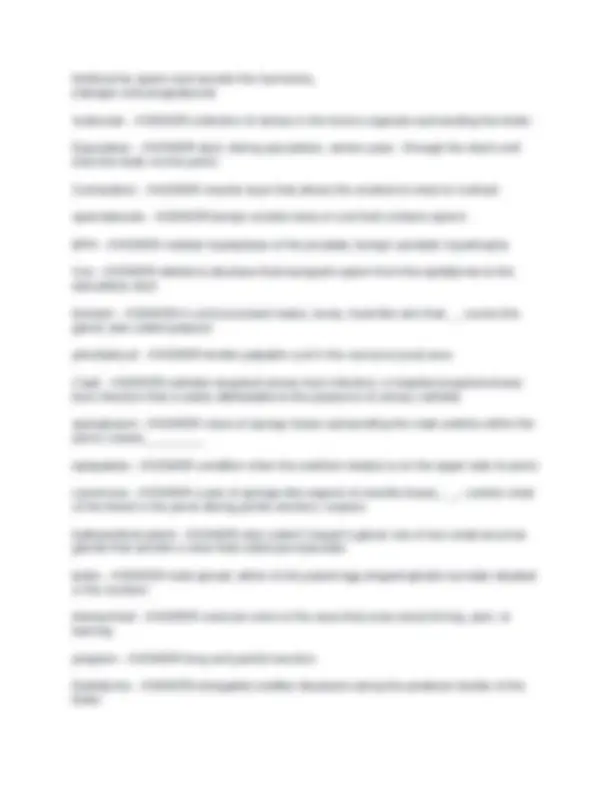
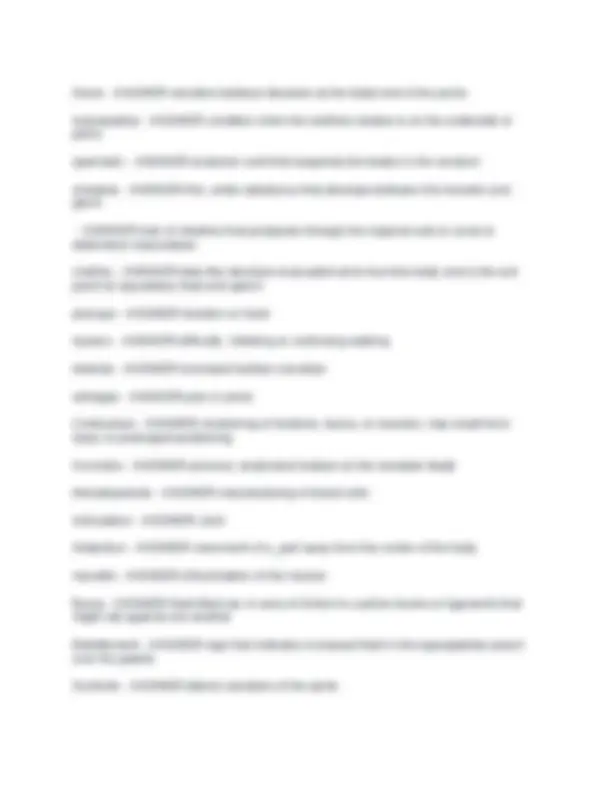
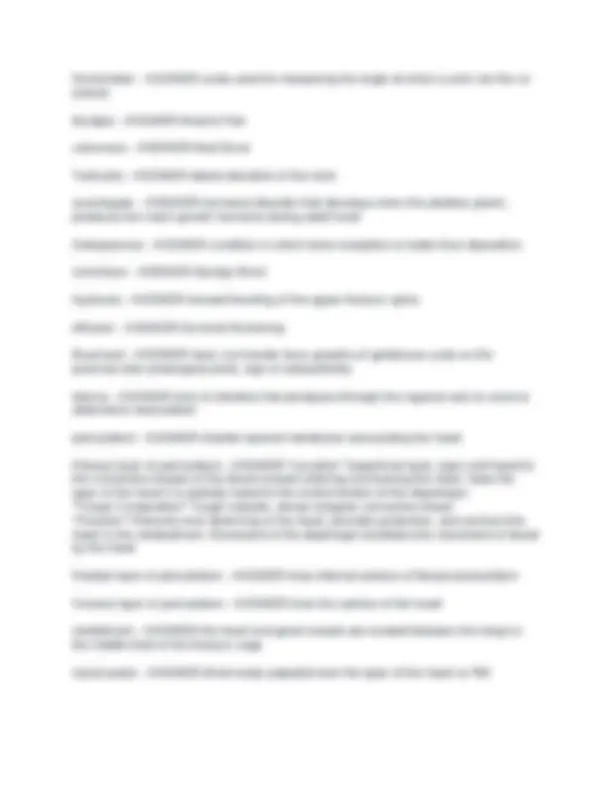
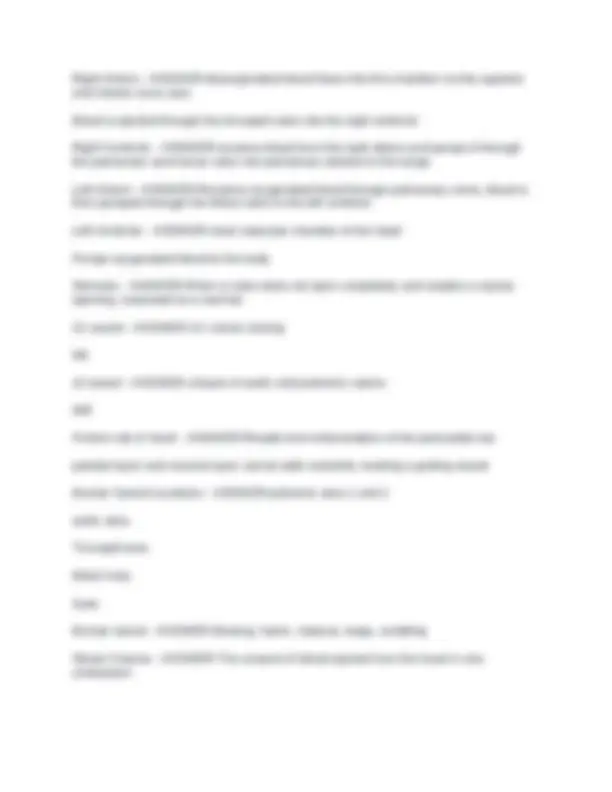



Study with the several resources on Docsity

Earn points by helping other students or get them with a premium plan


Prepare for your exams
Study with the several resources on Docsity

Earn points to download
Earn points by helping other students or get them with a premium plan
Community
Ask the community for help and clear up your study doubts
Discover the best universities in your country according to Docsity users
Free resources
Download our free guides on studying techniques, anxiety management strategies, and thesis advice from Docsity tutors
A comprehensive review of key concepts and terms for nursing 142, covering essential topics such as health history, nursing process, pain assessment, and erikson's developmental stages. It includes definitions, explanations, and examples to aid in understanding and preparation for exams. Particularly useful for nursing students seeking a concise and organized resource for their final review.
Typology: Exams
1 / 35

This page cannot be seen from the preview
Don't miss anything!




























Health History - ANSWER-Information about a patients health in his or her own words and based on the patients own perception. Includes biographic data, perceptions about health, past and present history of illness or injury, Family History, a review of systems, and health. Primary Souce - ANSWER-The patient is the best source because he or she can describe personal symptoms, experiences, and factors leading to the current concerns. Secondary Source - ANSWER-A person or record that beyond the patient that provides additional information about the patient. The interview - ANSWER-Subjective data gathering, including the health history and focused interview, that include primary and secondary sources Focused Interview - ANSWER-An interview that enables the nurse to clarify points, to obtain missing information, and to follow up on verbal and nonverbal cues identified in the health history Components of Health History - ANSWER-Biographic Data History of Present Illness Past Medical History Family Medical History Psychosocial History Review of Body Systems Biographic Data - ANSWER-Name, DOB, Birthplace, Sex, Marital Status, Gender Identity, Sexual Orientation, Race, Religion, Occupation, Health Insurance, Source of information/ Reliability. History of Present Illness - ANSWER-Reason for Seeking Care Health Beliefs and Practices Health Patterns: Lifestyle, Nutrition, and Activity Medications: Prescription and OTC meds
Past Medical History - ANSWER-Medical Surgical Hospitalization Outpatient Care Childhood Illness Immunizations Mental and Emotional Health Allergies Substance Use Family Medical History - ANSWER-Immediate Family Extended Family Genogram and Pedigree Nursing Process - ANSWER-A rational and dynamic process used by the nurse to plan for and provide patient care Assessment Diagnosis Planning Implementation Evaluation Psychosocial History - ANSWER-Occupational History Education Financial Background Roles and Relationships Family Social Structures/ Emotional Concerns
Treatment Components of Wellness - ANSWER-physical, emotional, intellectual, spiritual, social, environmental Stages of Wellness - ANSWER-Primary Secondary Tertiary Primary Stage of Prevention - ANSWER-interventions that occur to promote health and well being before a problem occurs Immunizations, etc Diverstiy - ANSWER-The state of being different. HIPAA - ANSWER-Health Insurance Portability and Accountability Act of 1996 only individuals involved in direct patient care are allowed to access the patients health record Why is Culture/diversity important in Nursing? - ANSWER-When Nurses understand diversity, apply cultural and spiritual knowledge, and act in cultural and spiritually competent ways, the can be more effective in assessing patients, developing culturally and spiritually sensitive interventions, and influencing healthcare Policy and Practice. Pain - ANSWER-A Highly unpleasant sensation that affects a person's senses and emotion and is associated with real or potential tissue damage Acute Pain - ANSWER-Pain that only lasts through the expected recovery of an illness, injury or surgery, whether it has a sudden or slow onset and regardless of intensity. Chronic Pain - ANSWER-Prolonged , usually reoccurring and persisting over 6 months or longer. Pain Rating Intensity Scale - ANSWER-Pain Scale from 0 to 10. OLDCART & ICE - ANSWER-Onset Location Duration Characteristics Aggravating factors Relieving factors Treatment &
Impact on ADLs Coping strategies Emotional response Why do we assess pain - ANSWER-most people would not be vocal about it capillary refill - ANSWER-A test that evaluates distal circulatory system function by squeezing (blanching) blood from an area such as a nail bed and watching the speed of its return after releasing the pressure. skin turgor - ANSWER-A reflection of the skin's elasticity, measured by monitoring the time it takes for the skin on he back of the hand to return to position after it is lightly pinched between the examiner's thumb and forefinger. Normal turgor is a return to normal contour within a few seconds; if the skin remains elevated (tented) more than a few seconds, turgor is decreased. pitting edema - ANSWER-Condition in which interstitial spaces contain such excessive amounts of fluid that the skin remains depressed after palpation. Scale from 1 to 4. 1 Being mild, and 4 indicates deep edema Ericksons Developmental Stages - ANSWER-have 8 developmental stages that start from infancy to older adulthood Infancy - ANSWER-Birth-18 months Trust versus mistrust Development of basic trust and sense of security Outcomes of Failed Task Accomplishment: Lack of trust, sense of fear Early Childhood - ANSWER-18 months- 3 years Autonomy versus shame and doubt Basic awareness of independence; sense of autonomy and self-control Outcomes of Failed Task Accomplishment-doubt, sense of helplessness, heightened dependence on caregivers Late childhood - ANSWER-3-5 years Initiative versus guilt Emergence of basic sense of self-guidance and self-discipline outcome of failed Task: Impaired self-initiative, insecurity regarding leadership ability
outcome of failed task: Life experiences framed by bitterness and/or regret; may progress to hopelessness and depression Assessment - ANSWER-The collection, organization, and validation of subjective and objective data Begins when nurse first meets patient Diagnosis - ANSWER-Use of critical thinking and application of knowledge from the sciences and other disciplines to analyze and synthesize data Planning - ANSWER-Priority setting Stating patient goals or outcomes Selecting nursing interventions Implementation - ANSWER-Putting the nursing interventions into action Promotes patient's achievement of goals or outcomes Evaluation - ANSWER-Comparing the patient status to the stated goals or outcomes A single nursing diagnosis may generate more than one patient goal. PERRLA - ANSWER-pupils equal, round, reactive to light and accommodation Alert and Oriented - ANSWER-measuring of mental function, measured in orientation to person, place, time, and situation. If a person is oriented to all 4, it is recorded as A&Ox MOE X4 - ANSWER-movement of extremities, equal motor strength Brundzski Test - ANSWER-Passive Flexion of Neck-Checks for Meningitis Romberg test - ANSWER-Ask the patient to stand about 2 feet in front of you, with his feet together, toes pointed forward, and his hands at his sides. While you extend your hands so that one is on either side of the patient, ask him to close his eyes. Watch to see how well he can maintain balance in that position. A minimum of swaying is normal, but if the patient sways more than a couple of inches, stop the test and document that he demonstrated difficulty maintaining balance Babinski reflex - ANSWER-Plantar reflex. Test it on the plantar aspect or sole of the foot by tracing an upside-down J with the handle of the reflex hammer, starting at the patient's heel and moving up the lateral aspect and then across the ball of the foot. Adult-Toes Curl Up Child-Toes Fan Out
Palpation - ANSWER-examination of the body using the sense of touch. The pads of the fingers are used because their concentration of nerve endings makes them highly sensitive to tactile discrimination Palpitation is to determine - ANSWER-Texture (e.g., of the hair) Temperature (e.g., of a skin area) Moisture Vibration (e.g., of a joint) Swelling Rigidity or spasticity Crepitation Location, position, size, consistency, and mobility of organs, lumps, or masses Distention (e.g., of the urinary bladder) Amplitude of pulses The presence of tenderness or pain. two types of palpitation - ANSWER-light and deep light palpitation - ANSWER-(superficial) palpation should always precede deep palpation because heavy pressure on the fingertips can dull the sense of touch. For light palpation, the nurse extends the dominant hand's fingers parallel to the skin surface and presses gently while moving the hand in a circle. the skin is slightly depressed. If it is necessary to determine the details of a mass, the nurse presses lightly several times rather than holding the pressure Deep Palpitation - ANSWER-done with one hand or with two hands (bimanually). In deep bimanual palpation, the nurse extends the dominant hand as for light palpation, then places the finger pads of the nondominant hand on the dorsal surface of the distal interphalangeal joints of the middle three fingers of the dominant hand Percussion - ANSWER-the act of striking the body surface to elicit sounds that can be heard or vibrations that can be felt. Secondary Stage of Prevention - ANSWER-Focus on early diagnosis of a health problem and prompt treatment for restoration of health Screenings, Blood tests, x-rays, etc Tertiary Stage of Prevention - ANSWER-Actively aimed a restoring the individual to the highest level of health and functioning Rehab, etc
Superior Rectus - ANSWER-Elevates eye and turns it medially, CN III (oculomotor) Lateral Rectus - ANSWER-moves eye laterally (CN VI) Inferior Rectus - ANSWER-Depresses eye and turns it medially, CN III (oculomotor) Superior Oblique - ANSWER-moves eye inferiorly and laterally, CN IV Medial Rectus - ANSWER-moves eye medially (CN III) Inferior oblique - ANSWER-elevates eye and turns it laterally (CN III) olefactory - ANSWER-Cranial Nerve I-Sensory-Smell Have PT identify smell Optic - ANSWER-Cranial nerve II-Sensory-Vision/Visual Fields Snellen Chart Test Oculomotor - ANSWER-Cranial Nerve III-Motor-EOM; movement of sphincter of pupil; movement of ciliary muscles of lens Six Cardinal Position, and Pupil Reaction Trochlear - ANSWER-Cranial Nerve IV-Motor-EOM; specifically, moves eyeball downward Six Cardinal Positions Trigeminal ophthalmic branch - ANSWER-Cranial Nerve V-Sensory-Sensation of cornea, skin of face, and nasal mucosa While patient looks upward, lightly touch the lateral sclera of the eye with sterile gauze to elicit blink reflex. To test light sensation, have patient close eyes, wipe a wisp of cotton over patient's forehead and paranasal sinuses. Maxillary branch - ANSWER-Cranial Nerve V-Sensory-Sensation of skin of face and anterior oral cavity (tongue and teeth) Assess skin sensation as for ophthalmic branch above. Mandibular branch - ANSWER-Cranial Nerve V-Sensory & Motor-Muscles of mastication; sensation of skin of face
PT to clench teeth Abducens - ANSWER-Cranial Nerve VI-Motor-EOM; moves eyeball laterally Assess directions of gaze. Facial - ANSWER-Cranial Nerve VII-Motor & Sensory-Facial expression; taste (anterior two thirds of tongue) Ask patient to smile, raise the eyebrows, frown, puff out cheeks, close eyes tightly. Ask patient to identify various tastes placed on the tip and sides of tongue: sugar (sweet), salt, lemon juice (sour), and quinine (bitter); identify areas of taste. Cochlear branch - ANSWER-Cranial Nerve VIII-Sensory-Hearing: air-conduction and bone-conduction Gross hearing acuity tests Normal tone, whisper tone Weber's test, and Rinne test with tuning fork Vestibular Brach - ANSWER-Cranial Nerve VII-Sensory-Equilibrium Romberg's Test Glossopharyngeal - ANSWER-Cranial Nerve IX-Motor and Sensory-Swallowing ability, tongue movement, taste (posterior tongue) Apply tastes on posterior tongue for identification. Ask patient to move tongue from side to side and up and down. Vagus - ANSWER-Cranial Nerve X-Motor and sensory-Sensation of pharynx and larynx; swallowing; vocal cord movement Assessed with cranial nerve IX; assess patient's speech for hoarseness. Accessory - ANSWER-Cranial Nerve XI-Motor-Head movement; shrugging of shoulders Ask patient to shrug shoulders against resistance from your hands and turn head to side against resistance from your hand Hypoglossal - ANSWER-Cranial Nerve XII-Motor-Protrusion of tongue; moves tongue up and down and side to side Ask patient to protrude tongue at midline, then move it side to side.
Wheezes - ANSWER-Air passage through a constricted bronchus gurgles/Rhonchi - ANSWER-Air passing through a narrowed air passage as a result of secretions, swelling, or a tumor crackles - ANSWER-air passage through fluid or mucous Friction Rub - ANSWER-Rubbing together of inflamed pleural surfaces Base - ANSWER-Refers to the bottom of the lung fields Apex - ANSWER-Very top of the lungs Cerumen - ANSWER-Waxy substance that is a combination of of substances secreted by apocrine sweat glands and sebaceous glands in the external ear canal(linked to ethnicity) Excursion - ANSWER-Movement of the thoracic diaphragm during breathing; Normal 3- 5cm; percuss for movement; should be even on both sides Fermitus - ANSWER-Palpable vibration on the chest wall when the patient speaks; strongest over trachea, diminishes over bronchi and becomes almost nonexistent over the alveoli of the lungs Palpation - ANSWER-skill of assessing the patient through the sense of touch to determine specific characteristics of the body. Percussion - ANSWER-Striking through a body part with an object, fingers, or reflex hammer, producing a measurable sound Turbulent - ANSWER-fast stigmatism - ANSWER-familial condition in which the refraction of the light is spread over a wide area rather then a distant point on the retina; cornea curves more in one direction then the other; vision may become blurred or doubled presbyopia - ANSWER-farsightedness caused by loss of elasticity of the lens of the eye, occurring typically in middle and old age. Myopia - ANSWER-nearsightedness; inability to see objects at a distance distal - ANSWER-farthest from the midline proximal - ANSWER-closest to the center of the midline
Broncial - ANSWER-heard anteriorly over the trachea; harsh and high pitched sounds, heard when patient inhales and exhales Pulmonary-Abnormal - ANSWER-Pallor, cyanosis, arrhythmia, or grayness Misalignement of clavicles; COPD? Asymmetry: may indicate a postural problem or underlying respiratory dysfunction Barrel chest - ANSWER-aging and accompanies COPD Funnel Chest - ANSWER-congenital; depression of the sternum and adjacent costal cartilage; divot between the pecks Scoliosis - ANSWER-lateral curvature and rotation of the thoracic and lumber spine; may result in the elevation of shoulder and pelvis; greater then 45 degrees may cause distortion of the lung and decrease lung volume Pigeon Chest - ANSWER-congenital forward displacement of the sternum with depression of the adjacent costal cartilage Kyphosis - ANSWER-exaggerated Posterior curvature of the thoracic spine; associated with aging; may decrease lung expansion and increase cardiac problems Pain may occur with inflammation Crepitus - ANSWER-crunching feeling under the skin caused by air leaking into subcutaneous tissue Asthma - ANSWER-Bronchospasm; mucosal edema and increased mucous excretion; wheezing and diminished breath sounds, absent breath sounds, increased resp rate, decreased o2 sat atelectasis - ANSWER-collapsed or impaired inflation of one or more areas of the lung; alveoli or an entire lung may collapse from the airway obstruction such as a mucous plug, lack of surfactant or a compressed chest wall; decreased or absent breath sounds, increased respiratory rate, decreased o2 sat and cyanosis Chronic Bronchitis - ANSWER-inflammation of the tracheobronchial tree; leads to mucus production and blocked airways; productive cough is present; fatigue, dyspnea, chronic cough, increased resp. rate, wheezes and rhonchi Emphysema - ANSWER-chronic inflammation of the lungs leads to destruction of the alveoli and decreased elasticity of the lungs; air is trapped and lunger hyperinflate; air hunger and dyspnea, barrel chest and decreased chest expansion, cyanosis, hypercarbia, clubbing fingers, diminished breath sounds
pulmonary congestion with auscultation( wheezes or crackles at base) Pallor decreased chest wall expansion and tracheal deviation on the unaffected side Normal Ears - ANSWER-No redness, nodule, swelling, or legions No Pain, nodules, lesions or swelling on tragus and auricle, tragus should be moveable Mastoid process should have no lesions, pain , or swelling Tympanic membrane should be flat, gray, and translucent with no scars Pt should feel and hear vibrations of the turning fork PT should not sway during rhombergs test Normal Sinus - ANSWER-Nose should b symmetrical, shape, no skin lesions and no signs of infection. Proportionate Nares Equal size No abnormally colored drainage can breathe out of both nostrils no tenderness, swelling and is stable smoothness and stability in soft tissue No pain when palpated Red glow of fontal sinus and red glow over cheeks Mouth and Throat Normal - ANSWER-lips are symmetric, smooth, pink, moist, and without lesions Teeth should be white and smooth edges and free of debris Tongue is pink and moist with papillae on the dorsal surface check for lesions or nodules on tongue, tissue should be smooth Salivary glands should be visible with no pain, tenderness, swelling or redness
Tonsils should be pink and without inflammation, swelling, or lesions Keloid - ANSWER-scar tissue forms tissue injury; pink, red or flesh colored Otitis externa - ANSWER-infection of the out ear Redness, Swelling, scanty drainage, itching, fever, and enlarged lymph nodes Swimmers ear Tophi - ANSWER-Small white nodules on the helix or antihelix of the ear that contains uric acid crystals and is a sign of gout. Otitis Media - ANSWER-infection of the middle ear producing red, bulging eardrum, fever and hearing loss Perforation of the tympanic membrane - ANSWER-ruptured eardrum because of trauma or infection, dark spot on the ear drum scarred tympanic membrane - ANSWER-eardrum has white patches of scar tissue due to repeated ear infections; does not cause hearing loss deviated septum - ANSWER-displacement of the lower nasal septum, appears to have an outgrowth or shelf expitaxis - ANSWER-nose bleed nasal polyps - ANSWER-pale, round, firm, non painful overgrowth of nasal mucosa, caused by chronic allergic rhinitis perforated septum - ANSWER-hole in the septum, shining a penlight the nares on the other side Rhinitis - ANSWER-nasal inflammation from viral infection or allergy, watery often copious discharge. Sneezes and congestion Sinusitis - ANSWER-inflammation of the sinuses following an upper respiratory infection, facial pain and discharge. Fever, Chills, frontal headache or dull pulsating pain in the cheeks or teeth. ankyloglossia - ANSWER-fixation of the tip of the tongue to the floor of the mouth, shortened lingual frenulum. Congenital. apthous ulcers - ANSWER-small, round, white painful lesions, occurs singular or clusters on oral mucosa
conjunctiva should be moist and clear with no redness or drainage. Small blood vessels should be visible beneath the conjunctival surface Lens should be clear and sclera white Iris should be round and both the same color cornea should be clear with no irregularities pupils round equal size Palpating eye; no swelling or tenderness and firm eyeballs Pulmonary-Normal - ANSWER-pink undertones(normal oxygenation) clavicles should be the same height sternum-midline Resp Rate 12-20 RPM, should be smooth a symmetric Hight of scapulae should be even and vertebrae should be midline chest movement should be symmetric Muscle mass should be firm and underlying tissue smooth free of lesions and masses on chest blephratitis - ANSWER-inflammation of eyelid. staph infection. Red, scaly, and crusted lids, burns, itches, and tears basal cell carcinoma - ANSWER-seen on the lower lid and medial canthus Chlazionq - ANSWER-firm non-tender nodule on eyelid. Infection of the meibormian gland. hordeolum - ANSWER-staph infection of hair follicle on the margin of eyelid. Swollen, Red and Painful(Stye) Entropion - ANSWER-The inversion of the lid and lashes caused by muscle spasm of the eyelid. ptosis - ANSWER-drooping of the eyelid. Occurs with cranial nerve damage
periorbital edema - ANSWER-swollen, puffy lids. Occurs with crying, infection, trauma, and systemic problems exophthalmos - ANSWER-protrusion of one or both eyeballs conjunctivitis - ANSWER-infection of the conjunctiva, bacteria or virus(pinkeye) iritis - ANSWER-serious, redness around the iris and cornea. decreased vision and deep aching pain, pupil irregular subconjunctival hemorrhage - ANSWER-ruptured blood vessel that leads to blood accumulation in the subconjunctival space. Trauma, anticoagulant therapy, high bp, and elevated venous pressure pterygium - ANSWER-Non-cancerous growth that develops from the conjunctiva and extends onto the sclera; may also extend to the cornea hypthema - ANSWER-collection of blood in the anterior chamber of the eye. Blunt trauma. acute glaucoma - ANSWER-sudden increase in the intraocular pressure resulting from the blocked flow of the fluid from anterior chamber. Pupil oval shaped and dilated, cloud cornea, pain, halos, and decrease in vision catarat - ANSWER-opacity in the lens pingueculae - ANSWER-yellowish elevated nodules are caused by a thickening of the bulbar conjunctiva from prolonged exposure to sun, wind, and dust diabetic retinopathy - ANSWER-changes in the retina and its vasculature hypertensive retinopathy - ANSWER-changes in retina and vasculature; high bp age-related macular degeneration - ANSWER-condition of macular and central retina; gradual los s of central vision while peripheral vision remains intact. Systole - ANSWER-Refers to a phase of ventricular contraction. Ventricles have been filled and then contract to expel blood into the aorta and pulmonary arteries. Begins with the closure of the av valves(s1) and ends with the closure of the aortic and pulmonary valves(s2). Heart - ANSWER-an intricately designed pump composed of meticulous network of synchronized design